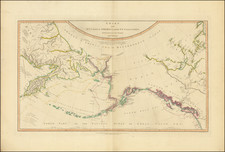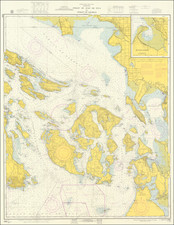Fairhaven, Washington -- Prospective Terminus of the Northern Pacific Railroad
Rare separately published promotional real estate map of Fairhaven, Washington, issued by the Fairhaven Land Company and printed by Rand McNally & Co.
Published in April 1890, this is quite possibly the first printed map of Fairhaven. We note that the map almost certainly pre-date the Hincks map of Fairhaven, based upon the Hincks depiction of significantly more subdivisions and built infrastructure.
The map notes that is was issued "Compliments of the Fairhaven Land Company" and bear the ink stamp of "Frank J. Hamilton, Real Estate Loans, Fairhaven, Wash."
The map depicts the rapid growth of Fairhaven relating to the boom times prior to the 1893 depression, with a number of land owners, additions and small communities arrayed around the outer limits of the town. Includes a small inset map of Puget Sound, colored to show the coastal counties from Olympia to New Blaine.
The map depicts only the line of the Fairhaven & Southern Railroad, pre-dating the arrival of the Great Northern Railroad, the Canada Pacific Railroad, and the creation of the Fairhaven and New Whatcom Electric Railway. Other built infrastructure includes:
- Fairhaven Wharf
- Hill & Moreland Wharf
- Ocean Wharf
- Bellingham Wharf
- Bellingham Mill
- Whatcom Wharf
- Sehome Wharf
- Coal Bunkers
There are numerous subdivisions shown and a number of pencil notes from an early real estate speculator.
Fairhaven: From "Dirty Dan" to Bellingham
The original blueprint for Fairhaven was laid down on January 2, 1883, by the eccentric and intriguing figure, Daniel J. Harris.
Daniel Jefferson Harris, better known as "Dirty Dan", first set foot in the Bellingham Bay area between 1853 and 1854. Establishing early ties, he collaborated with John Thomas, who had already claimed a piece of land along Padden Creek. Together, they began constructing a cabin. However, tragedy struck when Thomas died, leaving the cabin incomplete. Seizing the opportunity, Harris finalized the land claim, with the patent being officially issued in 1871. Over time, Harris expanded his acquisitions, and the area was christened Fairhaven, inspired by the native term "see-see-lich-em," meaning "safe port" or "fair haven." Some believe the name might have also been influenced by a town in Maine, speculated to be Harris' birthplace. By 1883, Harris had plotted out the town and began trading plots.
However, in 1888, a significant transition occurred. Harris sold a majority of his Fairhaven assets to Nelson Bennett and ventured off to California. Bennett, teaming up with Charles Larrabee who arrived in 1890, set up the Fairhaven Land Company, primarily financed by Larrabee. The duo was determined to elevate Fairhaven's status. They projected an image of a land abundant in resources, promising opportunities, and a climate of growth. This advertising gambit worked, and by the close of 1890, the population ballooned from a mere 150 in 1889 to an impressive 8,000. This growth was also catalyzed by the Fairhaven Land Company's acquisition of a neighboring settlement, Bellingham.
Amidst this whirlwind of development in the late 1870s to mid-1880s, Fairhaven, like many coastal cities in Washington, was in the race to become the terminal city for the Great Northern Railroad. Though Seattle was eventually chosen, the city's continued to grow and on May 13, 1890, Fairhaven was officially incorporated.
However, the town's rapid ascent was soon met with a steep decline. In the years 1890-1892, buildings sprouted in abundance, only to be abruptly halted by the devastating economic depression of 1893. The dawn of the 20th century brought with it a phase of gradual growth, culminating in Fairhaven's union with the neighboring town of Whatcom in 1903, to form the town of Bellingham.
Rarity
The map is extremely rare.
OCLC locates copies at Washington State University and Wisconsin Historical Society Library and Archives.











![[ Lake Hancock / Middle Fork Snoqualmie River / Kings County ] Township No. 24 North, Range No. 9 East. Willamette Meridian, Washington](https://storage.googleapis.com/raremaps/img/small/101646.jpg)
![[Oregon Territory] Carte de l'Oregon (and) [Astoria Factory]](https://storage.googleapis.com/raremaps/img/small/77722.jpg)
![[ Jefferson County - Olympic National Forest ] Quinalt Indian Reservation Township No. 24 North, Range No. 12 West, Willamette Meridian Washington](https://storage.googleapis.com/raremaps/img/small/101909.jpg)
![[ Northern Pacific Railroad ] NEW 7-30 GOLD LOAN OF THE Northern Pacific Railroad Co. SECURED BY FIRST MORTGAGE ON RAILROAD AND LAND GRANT. SAFE! PROFITABLE! PERMANENT!](https://storage.googleapis.com/raremaps/img/small/101828.jpg)